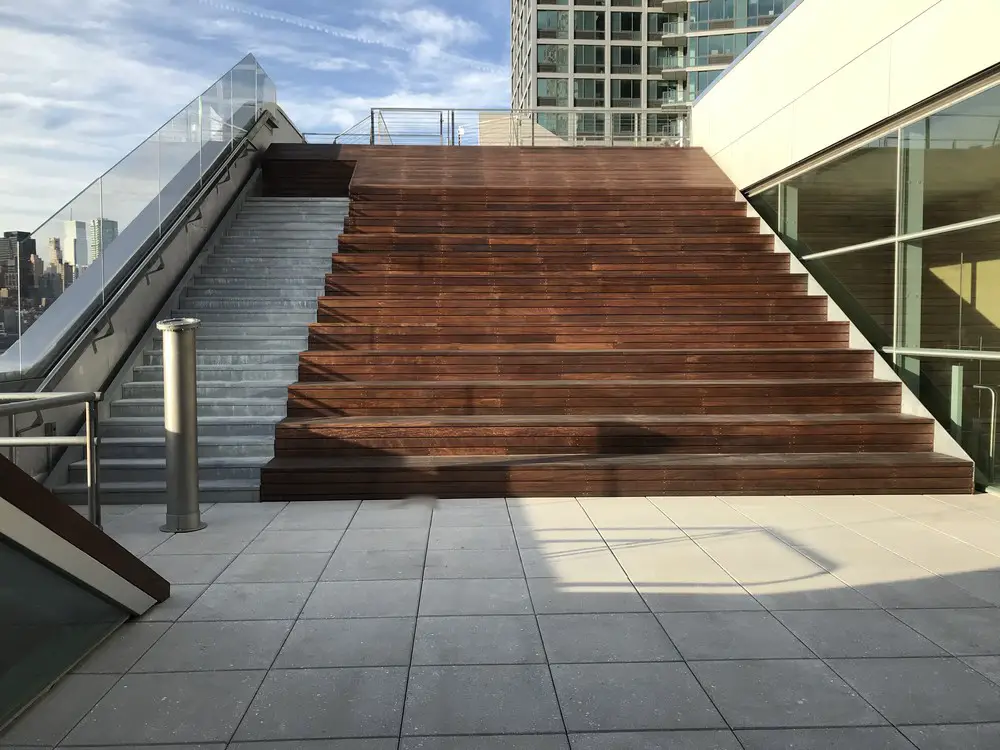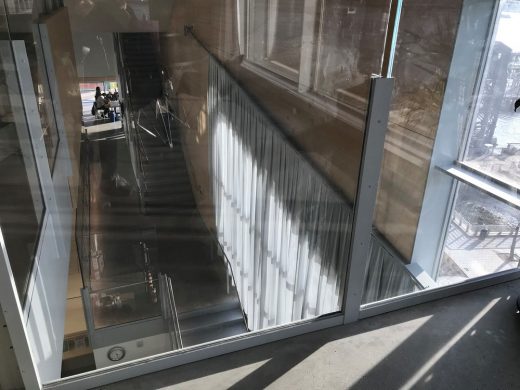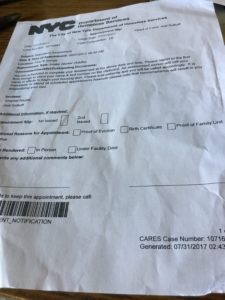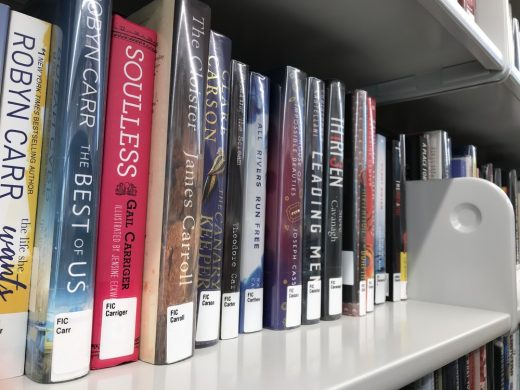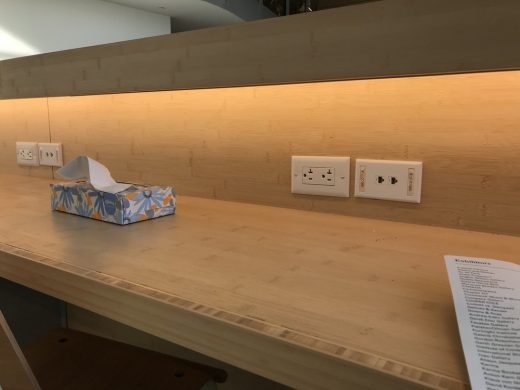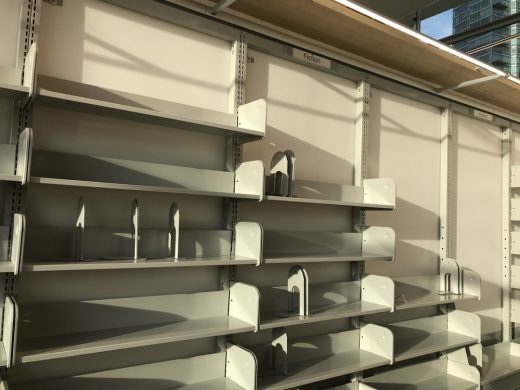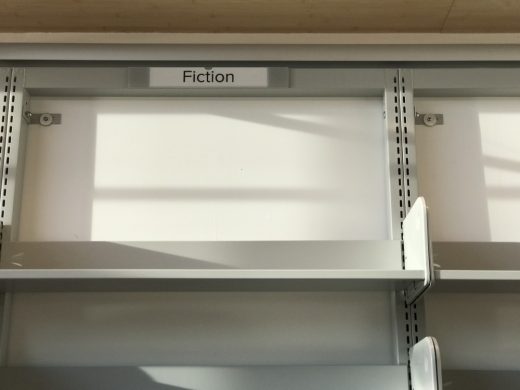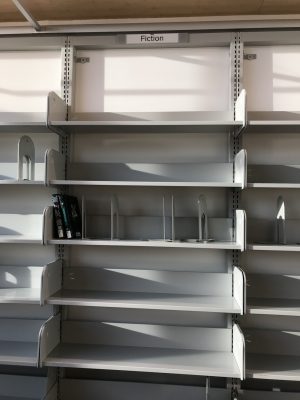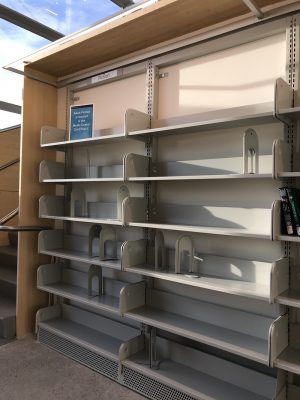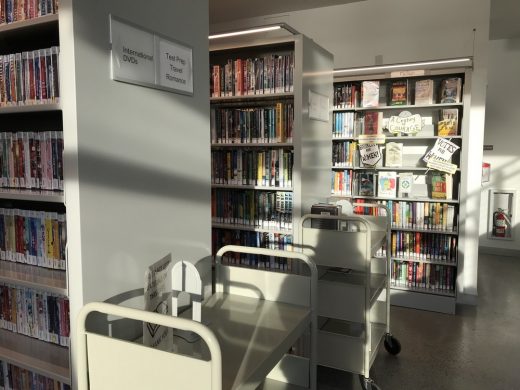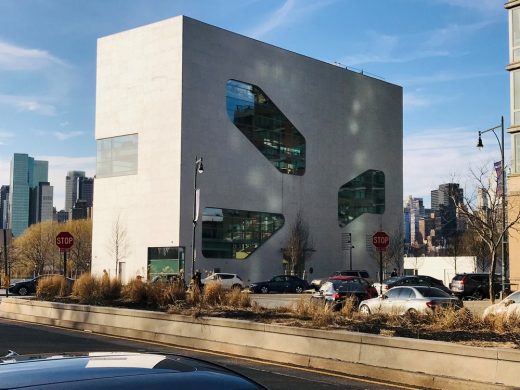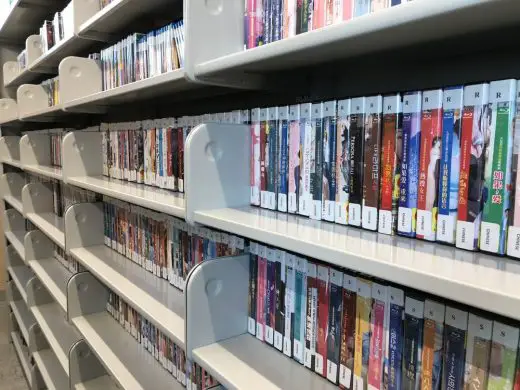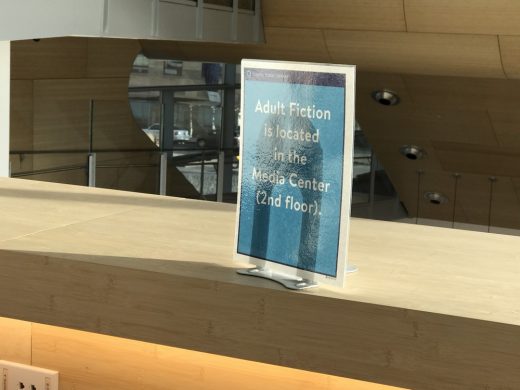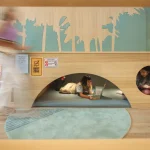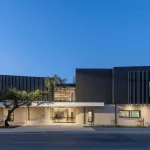Profile of New York City’s library inaccessible Mayor, NY Architecture, Queens Public Library
New York City Mayor Bill de Blasio
Joel Solkoff’s Column Vol. VI, Number 2
reporting on New York City, the City of my birth, from a difficult 189 mile drive away from remote Williamsport, Pennsylvania: a town of 28,000, which is an architecture treasure
“A building should not stand out. It should fit in.”
— Lewis Mumford, my favorite architecture critic
March 6th, 2020
Bill de Blasio – New York City Mayor
NYC Mayor Bill de Blasio is a defendant in the Queens library disability-rights law suit which he will lose.
For five years, Mayor de Blasio served ex officio on the Board of Trustees of the Queens Borough Public Library which planned and oversaw the Hunters Point project and which, based on over 60 years of intense experience with libraries clearly failed to include the design requirements of the library profession which I so love.
Beyond simply the issue of the failure of Steven Holl’s project is my personal view of Mayor de Blasio, whose inauguration I initially greeted with enthusiasm, because he was elected with the promise of preserving low- and medium-income neighborhoods in the city of my birth. Consider the following post on my personal website:
”Finally, out of the politics of despair and retrenchment, a new leader has emerged from the Democratic party unafraid to express the values in which I believe. In this, Bill de Blasio’s inaugural address, he states:
“‘Fiorello La Guardia — the man I consider to be the greatest Mayor this city has ever known — put it best. He said: I, too, admire the ‘rugged individual,’ but no ‘rugged individual’ can survive in the midst of collective starvation.’”
http://www.joelsolkoff.com/new-york-city-mayor-bill-de-blasios-inspiring-inaugural-address/
Then, reality interviewed first in the form of persistent convincing still on-going reports that the Mayor has failed to redeem his promise to the City’s most vulnerable citizens:
“New York City is in the throes of a humanitarian emergency, a term defined by the Humanitarian Coalition of large international aid organizations as ‘an event or series of events that represents a critical threat to the health, safety, security or wellbeing of a community or other large group of people.’ New York’s is what aid groups would characterize as a ’complex emergency’; man-made and shaped by a combination of forces that have led to a large-scale ’displacement of populations’ from their homes. What makes the crisis especially startling is that New York has the most progressive housing laws in the country and a mayor who has made tenants’ rights and affordable housing a central focus of his administration.
”The tide of homelessness is only the most visible symptom. There are at least 61,000 people whose shelter is provided, on any given day, by New York’s Department of Homeless Services.”
— Tenants Under Siege: Inside New York City’s Housing Crisis by Michael Greenberg, The New York Review of Books, August 17, 2017
https://www.nybooks.com/articles/2017/08/17/tenants-under-siege-inside-new-york-city-housing-crisis/
In de Blasio’s dedication speech of Renzo Piano’s Whitney he said:
“If, in all the different action movies, there was an architect superhero – first of all, he would do the things that Renzo Piano does. Second of all, his name would inevitably be Renzo Piano.”
https://www1.nyc.gov/office-of-the-mayor/news/274-15/transcript-mayor-de-blasio-delivers-remarks-dedication-ceremony-ribbon-cutting-whitney#/0
++++
“Cepeda is one of the dozens of mostly homeless people streaming out of a Chelsea church’s soup kitchen one morning in mid-October, bearing paper-wrapped buttered bagels and Styrofoam cups of tea. He’s just been told that the New York City Department of Homeless Services (DHS) has a new pilot program that will help pay homeless people’s rent for up to twelve months if they find housing outside the city.
“The unnamed program, which began quietly on September 1, drew public attention in late September, after DHS sent a group of shelter residents to look at seventeen apartments in Newark, New Jersey. Republican mayoral candidate Nicole Malliotakis called it an example of the failure of Mayor Bill de Blasio’s policies on homelessness, accusing him of spending ‘the taxpayers’ money’ to subsidize out-of-town rents. For others, paying for poor people to leave raised the specter of the Louisiana segregationists in the 1960s who bought public-assistance recipients one-way bus tickets up North,…”
—What de Blasio’s ‘Paying the Homeless to Leave Town’ is All About by Steven Wishnia, Village Voice, October 18, 2017
https://www.villagevoice.com/2017/10/18/what-de-blasios-paying-the-homeless-to-leave-town-program-is-really-about/
++++
“A top goal of Mayor Bill de Blasio’s “Where We Live” plan: “The City of New York must ensure that its residents have realistic options to live in quality, affordable housing in a variety of thriving neighborhoods.
“But when it comes to its own Housing New York development programs to build 120,000 new affordable apartments, the administration has so far spurred new affordable housing in patterns that reinforce existing divides — most often steering the poorest tenants to the poorest parts of the city, an analysis by THE CITY finds.”
— Mayor’s Affordable Housing Program Struggles to Integrate New Yorkers by Income by Rachael Holliday Smith and Ann Choi. The City, January 21, 2020
++++
There years after Mayor de Blasio took office, his misadministration of New York’s vulnerable population made me uncomfortable personally. I had rushed to Manhattan to attend the funeral of a dear friend. By misadventure, my housing plans fell through. Shortly after arriving at Penn Station, I found myself bussed to the northern end of Brooklyn, a hop, skip, and jump away from Hunters Point Queens.
There at the Greenpoint neighborhood of Brooklyn, I resided for two days in a homeless shelter. This homeless shelter currently houses 65 individuals. What follows are my photographs and notes compiled one day after exiting:
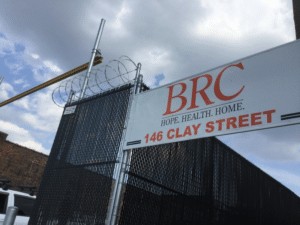
Shelter entrance. Notice the barbed wire. Photo by Joel Solkoff
Tuesday, August 1, 2017. This morning I left a homeless shelter in Brooklyn, New York where I spent the last two nights.
++++
Last night I returned “home” at 9:30. The hard and fast curfew is 10. The three or four uniformed guards made sure I was secure. My backpack was scanned by an airline-grade machine. Previously, my backpack had revealed a bottle of water. It had been seized. No glass permitted. Between the imposing scanner and the other device most everyone had to go through for detection of metal objects, the otherwise adequate space presents a fortress-like appearance. Being in a wheel chair, I was ”lightly patted down” then cleared.
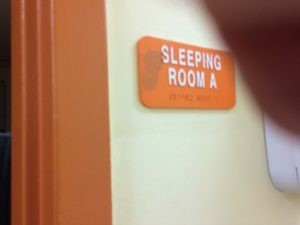
Inside Room A was my bed–Number 017. We residents were not referred to by name; rather by bed number. Photo by Joel Solkoff
Ordinarily, I would have gone to the bathroom before bed. Brushing my teeth, for example, my dentist recommends. However, on Monday morning, I had awakened to the realities of the bathroom.

I took this photograph at 2 AM Tuesday morning. Going to the bathroom could no longer be postponed. As I considered washing my hands, a fellow resident had just finished scrubbing out the basin to the right of this photograph. He invited me to wash my hands where it was clean.
The resident of bed number 014 walked up to me and suggested I complain to the staff because I was not close to an electrical outlet required to charge my mobility device. The shortage of electrical outlets was severe. Several of the 20 or so residents of Sleeping Area A had iPhones. Cell phones were the principal way homeless residents connect to the world. The shortage of electrical outlets at the homeless shelter meant several of us had to huddle at one outlet to recharge our phones. A 100 percent charge was considered a luxury.
Huddled around the electric plug after 11 pm, we residents tried to obtain enough electricity to be able to communicate with the outside world.
At 11, a member of the staff turned off the lights.
The lights did not remain off for long.
The rules are important at the homeless shelter. Before being allowed to sleep, I was required to sign each of 16 pages.
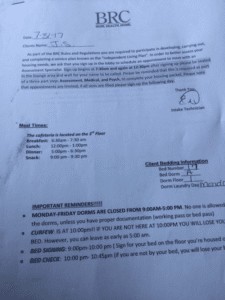
At 2:30 AM Sunday (actually Monday), I was given 16 pages of rules to sign at the shelter’s intake center. This was my second intake. The first was on 30th Street and First Avenue. Had I known I would be sent to Brooklyn I may not have gone. Although at that point, I would have gone anywhere for a bed to sleep upon.
At 11:02 precisely, the quiet in the sleeping room was broken when I heard a staff member yelling. She was in the bathroom apparently staring at an occupied stall, telling the resident that he should be in bed. She said that because he was in the bathroom rather than in his bed, she was taking his bed away from him and he would have to leave the shelter.
The issue appeared to be resolved when another resident told her that the man in the bathroom did not speak English. She sought to rectify the situation by yelling at him more loudly. I do not know whether the resident was allowed to sleep in the bed he had been assigned in another sleeping room. I suspect he was allowed.
Sometime between 1 and 1:15 AM a staff member woke me from a deep sleep shaking my arm until I was sufficiently alert. She handed me this piece of paper informing that at 8 AM I had an appointment for a mandatory assessment. She insisted I sign a piece of paper affirming. I signed. Immediate return to sleep was difficult. Another staff member turned on the bright lights. Other names and bed numbers were called and the lights remained on until the last of the relevant residents had signed.
Shortly after 3 AM I awoke and was unable to return to sleep. I brushed my teeth and washed my hands and face. The showers were not only dirty–filthy. None of the showers was a wheel chair roll in. Attempting a shower would have been dangerous. Instead, I got dressed, packed, and attempted to leave. At the front door, a staff member informed me I could not leave the building. She said I had to wait until 5 AM. I said I wanted to leave now. She said, “Well, I guess I cannot stop you.”
Greenpoint Brooklyn homeless shelter Exit:
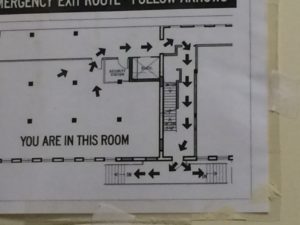
++++
Mayor Bill de Blasio speaking in Iowa 2019:

Photo by Gage Skidmore. Published under terms of the Wikipedia Commons license.
++++
Wikipedia: “Bill de Blasio (/dɪˈblɑːzioʊ/; born Warren Wilhelm Jr.; May 8, 1961 (he is 12 years younger than I) is an American politician who has served as the 109th mayor of New York City since 2014. A member of the Democratic Party, he was New York City’s public advocate from 2010 to 2013.
https://en.m.wikipedia.org/wiki/Bill_de_Blasio
This column begins a series which will continue to focus on the US and global implications of The Hunters Point library scandal
What’s next?
The growing power of the disability rights movement and our ability to redefine the word “architect.”
NB. The vast majority of the disabled are Baby Boomers. The slogan of the international disability rights movement:
Nothing about us without us.
++++
My editors beckon: “All right, stop writing, Joel.”
Isabelle Lomholt and Adrian Welch, Editors at e-architect
“Good night and good luck,” as Greensboro, North Carolina born Edward R. Morrow, my hero, used to say.
–Joel
2019: East Third Street
Williamsport, PA, US
17701
Phone: 570-505-1251 Room 310.
—30–
++++
What follows is the complete text (21 hard copy single-spaced pages) of the well-written federal lawsuit filed by the Center for Independence of the Disabled of New York (CID-NY) on behalf of plaintiff Tanya Jackson and the disabled members in the organization.
UNITED STATES DISTRICT COURT FOR THE EASTERN DISTRICT OF NEW YORK
TANYA JACKSON, an individual; and
CENTER FOR INDEPENDENCE OF THE
DISABLED, NEW YORK, a nonprofit
organization; on behalf of themselves and all
others similarly situated,
Plaintiffs,
COMPLAINT
No. 19-cv-6656
-against
QUEENS BOROUGH PUBLIC LIBRARY,
BOARD OF TRUSTEES OF QUEENS
BOROUGH PUBLIC LIBRARY, AND THE
CITY OF NEW YORK,
Defendants.
COMPLAINT
-against-
Plaintiffs,
QUEENS BOROUGH PUBLIC LIBRARY, BOARD OF TRUSTEES OF QUEENS BOROUGH PUBLIC LIBRARY, AND THE CITY OF NEW YORK,
Defendants.
INTRODUCTION
1. This class action lawsuit seeks to rectify the systemic, discriminatory exclusion of persons with mobility disabilities from full and equal access to Hunters Point Library, the brand new $41.5 million branch of Queens Borough Public Library that opened in September 2019.
2. Heralded as a “stunning architectural marvel” and a “beacon of learning, literacy and culture,” [Footnote 1] the newly-built Hunters Point Library was designed and built with a total disregard for adults and children with mobility disabilities and in flagrant contempt of the legal requirements of the Americans with Disabilities Act, which took effect in 1992, almost three decades ago.
3. Inaccessible features pervade the new Hunters Point Library (“the Library”), and exclude people with mobility disabilities from a variety of its offerings. For example, people with mobility disabilities are barred from using the three levels that are currently occupied by comfortable lounging and studying areas and large bookshelves, but which can only be accessed by stairs.
Footnote 1: Queens Public Library, Hunters Point Library Opens In Queens, QUEENS PUBLIC LIBRARY BLOG (Nov. 25, 2019, 12:49 PM), https://www.queenslibrary.org/about-us/news- media/blog/1918?utm_source=homepage&utm_medium=carousel&utm_campaign=hunterspointopening_BLG
4. Moreover, adults and children with mobility disabilities are excluded from a large reading and small-group meeting space on the children’s floor that is entirely inaccessible due to its multi-level wooden seating and a large entry step.
5. Visitors with mobility disabilities who seek to use or attend events on the rooftop terrace will be similarly excluded due to the stair-only access to the upper level of the bi-level rooftop terrace. Such visitors will be denied the upper level’s stunning views of the East River and Manhattan.
6. Additional barriers, such as the presence of only a single heavily-utilized elevator, designated stroller parking areas that block the already-narrow paths between the elevator and some of the Library’s main features, and a lack of seating in the lobby to use while waiting for the elevator further exacerbate the exclusion of people with disabilities.
7. In describing the failure to create an accessible design for the new Library, a senior partner at Steven Holl Architects, the firm that designed the Library, admitted that “[t]o be honest, we hadn’t thought, ‘O.K. we have to provide an exactly equivalent browsing experience.’” [Footnote 2] Such disregard for the legal rights of people with disabilities—decades after the passage of the ADA—is all too apparent in the Library’s design.
Footnote 2. 2 Sharon Otterman, New Library Is a $41.5 Million Masterpiece. But About Those Stairs. N.Y. TIMES, (Nov. 5, 2019), https://www.nytimes.com/2019/11/05/nyregion/long-island-city-library.html.
8. During the Library’s inaugural opening, Library executives stated, “there is far more to a library than its design and physical structure that makes it soar. It is the experience of coming to a place that welcomes you, no matter who you are or where you are from…That is the promise we are committed to fulfilling…at Hunters Point Library[.]” [Footnote 3] And yet people with mobility disabilities have not been welcomed and instead have been denied the civil rights and societal inclusion promised to them by the decades of disability rights laws that Defendants have ignored.
Footnote 3. Queens Public Library, supra note 1.
9. Such laws are particularly explicit that new construction—which presents an opportunity to provide full inclusion for people with disabilities—should be held to the strictest accessibility standards, since it is minimally expensive or difficult to design accessible features from the beginning. It is inexcusable for a new building to ignore accessibility in its design.
10. Plaintiffs sue on behalf of themselves and persons with mobility disabilities who are being discriminated against by virtue of the exclusion of people with mobility disabilities from the full access to and experience of visiting Hunters Point Library. Plaintiffs seek only injunctive relief, not monetary damages, to have the barriers effectively and permanently remediated.
JURISDICTION
11. This is an action for injunctive relief, brought pursuant to Title III of the ADA, 42 U.S.C. § 12181, et seq.; Title II of the Americans with Disabilities Act (“ADA”), 42 U.S.C. § 12131, et seq.; Section 504 of the Rehabilitation Act of 1973 (“Section 504”), 29 U.S.C. § 794; and the New York City Human Rights Law (“NYCHRL”), N.Y.C. Admin. Code § 8-101 et seq.
12. This Court has subject matter jurisdiction over this action under 28 U.S.C. §§ 1331 and 1343 for claims arising under the ADA and Section 504, and supplemental jurisdiction over NYCHRL claims pursuant to 28 U.S.C. § 1367.
VENUE
13. Venue is proper in this Court, pursuant to 28 U.S.C. § 1391(b), because Defendant is located within this District. Moreover, a substantial part of the events or omissions giving rise to the claims alleged herein occurred in this District.
PARTIES
Plaintiffs
14. Tanya Jackson lives in Long Island City, Queens and is a qualified person with a mobility disability. Ms. Jackson is a frequent library user but has been deterred from visiting or patronizing Hunters Point Library because of its inaccessibility. The one time Ms. Jackson did visit the Library, she was discouraged that she could not access all of its features, and is hesitant to return.
15. Center for Independence of the Disabled – New York (“CIDNY”) is an Independent Living Center that was founded in 1978 and has 40 years of experience removing barriers to full equality, independence, and self-determination. It works with people in all five boroughs with offices in Queens and New York Counties. In 2018, CIDNY served 52,310 people with disabilities throughout New York City.
Defendants
16. Defendant Queens Borough Public Library is a private non-profit corporation that operates the library system in Queens.
17. Defendant Board of Trustees of Queens Borough Public Library (“Defendant Board of Trustees”) is the governing body of Queens Borough Public Library. Its members are appointed by the City of New York and the Borough of Queens, and the Mayor of New York and other New York City officials sit on the Board in an ex officio capacity.
18. The City of New York (“Defendant the City”) controls, oversees, and funds Queens Borough Public Library’s operations and capital expenditures.
FACTS COMMON TO ALL ALLEGATIONS
19. Hunters Point Library is the newest branch of Queens Borough Public Library, built on the East River waterfront in Long Island City at a cost of approximately $41.5 million.
20. Defendants began designing Hunters Point Library in 2010, broke ground in 2015, and opened the new branch to much fanfare in September 2019.
21. Defendant the City, through its agency, the Department of Design and Construction (“DDC”), oversaw the construction of Hunters Point Library as part of its “Design and Construction Excellence Program” and provided much of the funding for the project. Footnote 4]
Footnote 4. Department of Design and Construction, Hunters Point Library Opens in Queens, PRESS RELEASE, (Nov. 25, 2019, 1:08 PM), https://www1. nyc.gov/site/ddc/about/press-releases/2019/pr-092419-hp-library.page.
22. When Hunters Point Library finally opened to the public, the New York City Deputy Mayor for Operations described it as “a cornerstone for New York City’s waterfront and
the Queens community for generations.” Footnote 5]
Footnote 5. 5 Otterman, supra note 2
Similarly, the New York City Deputy Mayor for Housing and Economic Development stated that “[w]e’re thrilled to deliver our promise to the LIC community to bring a state-of-the-art library, providing residents a place to gather, learn, and connect with their community.” [Footnote 6]
Footnote 6. Id.
23. However, because the Library is functionally and aesthetically designed around stairs and other architecturally inaccessible features, people with mobility disabilities are excluded from fully experiencing and utilizing this “state-of-the art…place to gather, learn and connect.”
24. Visitors with mobility disabilities encounter difficulty even entering the Library. Beside the main entrance—a revolving door—is a single wheelchair-accessible door, which is heavily trafficked by visitors with young children in strollers, causing people with mobility disabilities to have to wait to even use the door.
25. Upon entering the Library, visitors encounter a first-floor lobby that contains only a reference desk, a conference room, and restrooms; to access the rest of the Library, spread across several vertical levels, visitors are immediately confronted with two large staircases leading to the north and south ends of the Library.
26. Both staircases run along the west side of the Library, where large windows offer dramatic views of the East River and Manhattan. Anyone who cannot use these staircases is unable to fully experience these views.
27. There is a single elevator tucked away in an alcove off the main lobby on the east side of the Library, but it does not stop at every level of the Library and therefore provides no access to the building’s features that can only be reached by stairs.
28. For example, the north staircase runs along four separate tiered landings, each with bookshelves, seating areas, and electronics charging stations. The first of these four landings has lounge chairs, while the top three landings have built-in desks. The elevator stops at the first of the tiered landings off the north staircase, but it does not stop at the second, third, or fourth tiered landings. The only way to reach those landings, and the desks and seating areas they offer, is by using the stairs.
29. Additionally, the south staircase leads up to the children’s area. Although the elevator stops on the main children’s floor, visitors with disabilities will still be unable to use one of the children’s floor’s main features: A multi-tiered lounging and small group meeting area that visitors can use for reading, story time, or other activities. There is a large step leading into this section, so children and adults with mobility disabilities are barred from even sitting in the front row.
30. There is also a rooftop that remains under construction, but which will provide a public terrace with incredible views of the Manhattan skyline and the East River. The rooftop has two levels, at least one of which can only be reached by stairs. Additionally, Library employees tell people with mobility disabilities that they cannot access any portion of the rooftop.
31. The availability of only one elevator for this multi-story building is also a barrier to equal access as it is highly utilized throughout the day, particularly by the many visitors with young children in strollers, increasing wait times for people with mobility disabilities.
32. The absence of seating in the lobby or near the elevator means that people with mobility disabilities who have trouble standing for long periods of time will be particularly impacted by these wait times.
33. Moreover, the library has designated “stroller parking” along the path of travel from the children’s floor to the elevator that considerably narrows the path such that people using wheelchairs, scooters, walkers, or other mobility devices are blocked from reaching the children’s area.
34. The Library’s disregard for people with disabilities is further demonstrated by an inaccessible book return at the front entrance of the library. The automated system requires visitors to use a touch screen—without a headphone jack or any tactile features that would allow people who are blind or have low vision to return their books outside along with their sighted fellow Library patrons.
EXPERIENCES OF PLAINTIFFS
35. Plaintiff Tanya Jackson lives in Long Island City, Queens and uses a rollator (a type of walker) for mobility.
36. Because of Ms. Jackson’s mobility disability, she has difficulty walking and cannot use stairs.
37. Ms. Jackson is an avid public library user and holds a library card from the New York Public Library. She regularly visits public libraries to use their computers and other resources and to attend various community events. In particular, Ms. Jackson does not have her own computer and relies on the publicly available computers provided by libraries.
38. Ms. Jackson has lived in Long Island City for a little over a year. During that time, she has lamented the lack of a nearby library, and was looking forward to the opening of the much-anticipated Hunters Point Library. She had planned to regularly visit the Library to use the computers, read, relax in the quiet public space, and attend events held there.
39. Shortly after the Library opened, Ms. Jackson learned about its multiple barriers to accessibility. These barriers deterred Ms. Jackson from visiting the Library for several weeks because she was afraid that they would prevent her from being able to access the services that she needs.
40. Despite the brand-new Library opening up just 1.8 miles away from her residence, Ms. Jackson had to continue to navigate the inaccessible subway system to visit accessible libraries in Manhattan and the Bronx.
41. On November 18, 2019, when Ms. Jackson decided to finally visit the Library, she took the elevator to the upper levels. When she got to the fifth floor, she had to walk up a steep ramp to an indoor seating area. She asked a Library employee where the computer area was. The employee directed her down to the fourth floor.
42. To get back to the elevator, she had to use the same steep ramp, and had to walk very slowly, since she was worried that the decline would cause her rollator to move too quickly.
43. She later asked a Library employee near the computer area about the rooftop terrace. The employee told her that the rooftop is inaccessible to people who use wheelchairs, walkers, rollators, or scooters.
44. Ms. Jackson was very disappointed to learn that she would never be able to access the rooftop terrace, which has an excellent view of Manhattan. She felt that the view of Manhattan from the computer area was limited compared to what would be available on the rooftop and other areas that can only be reached by the stairs.
45. Ms. Jackson is afraid that she will not be able to fully participate in future events that the Library will host, including upcoming holiday events, because there are areas in the Library that are inaccessible to her.
46. Because stairs are featured throughout the Library and prevent Ms. Jackson from accessing all the Library’s benefits fully, she feels unwelcome and overlooked by all who had a hand in constructing the new Library. She has been harmed, and will continue to be harmed, by Defendants’ ongoing failure to abide by its ADA obligations.
47. Organizational Plaintiff CIDNY is a statutorily-defined Center for Independent Living and is subject to the control of its constituents. One of CIDNY’s core purposes is to engage in the sort of systems advocacy on their behalf that this lawsuit represents, see 29 U.S.C. § 796(a)(3) (“consumer control”) 29 U.S.C. §§ 705(17-18) (defining the “core services” and “services” of an independent living center), making it the functional equivalent of a voluntary membership organization.
48. CIDNY employs staff members who work directly with thousands of constituents each year, helping them to solve problems related to public accommodations, transportation, employment, housing, healthcare, education, and more.
49. The majority of CIDNY’s board members and employees are people with disabilities, as are nearly all of the people it serves. Many of these individuals have mobility disabilities.
50. CIDNY has constituents, staff, board members, and volunteers with mobility disabilities who seek to visit Hunters Point Library. Some of these individuals had hoped to visit Hunters Point Library but were deterred from doing so upon seeing the news coverage about Defendants’ failure to make it accessible for persons with mobility disabilities.
CLASS ALLEGATIONS
51. Pursuant to Rule 23(b)(2) of the Federal Rules of Civil Procedure, Plaintiffs bring this action, for injunctive relief purposes only, on their own behalf and on behalf of all persons similarly situated. The class that Plaintiffs seek to represent consists of all persons with mobility disabilities who visit or intend to visit Hunters Point Library, or who have been deterred from visiting Hunters Point Library because of its inaccessibility. The claims asserted herein are solely for injunctive relief for the class; damages claims are not included in this complaint.
52. The persons in the class are so numerous that joinder of all such persons is impracticable. The disposition of their claims in a class action is a benefit to the parties and to the Court. Indeed, more than 130,000 non-institutionalized Queens County residents have a
mobility-related disability. [Footnote 7] Hundreds of thousands of persons with disabilities, moreover, visit the City each year.
Footnote 7. DISABILITY CHARACTERISTICS 2013-2017 American Community Survey 5-Year Estimates; Queens County, New York, UNITED STATES CENSUS BUREAU, (Nov. 25, 2019, 1:39 PM), https://factfinder.census.gov/faces/tableservices/jsf/pages/productview.xhtml?pid=ACS_17_5YR_S1810&prodType =table.
53. Proposed class members share a well-defined community of interest with respect to the questions of law and fact involved because they are all being denied or deterred from full and equal access to Hunters Point Library.
54. One of the key common questions of law and fact involves Plaintiffs’ allegations that Defendants have violated federal law by failing to provide full and equal access to Hunters Point Library for persons with mobility disabilities. Common questions also include whether city law requires Hunters Point Library to be accessible for persons with mobility disabilities, as well as what remedial scheme should be implemented to rectify the current lack of access.
55. Moreover, Plaintiffs’ claims are typical of the claims of the class as a whole because Plaintiffs are similarly affected by Hunters Point Library’s inaccessibility.
56. Plaintiffs are adequate class representatives because they, or the persons they serve, are directly impacted by Defendants’ failure to provide equal access to Hunters Point Library, and because Plaintiffs’ interests are not antagonistic, or in conflict with, the interests of the class as a whole.
57. The attorneys representing the class are highly trained, duly qualified, and very experienced in representing plaintiffs in civil rights class actions for injunctive relief.
58. By failing to secure accessibility of Hunters Point Library consistent with federal disability access laws, Defendants have acted and/or failed to act on grounds generally applicable
to the class as a whole. Accordingly, an award of appropriate final injunctive relief with respect to the class as a whole is warranted in this case.
59. References to Plaintiffs shall include each Plaintiff and each member of the class, unless otherwise indicated.
FIRST CAUSE OF ACTION
VIOLATION OF TITLE III OF THE AMERICANS WITH DISABILITIES ACT (42 U.S.C. § 12181, ET SEQ.)
AGAINST DEFENDANTS QUEENS BOROUGH PUBLIC LIBRARY AND BOARD OF TRUSTEES OF QUEENS BOROUGH PUBLIC LIBRARY
60. Plaintiffs re-allege and incorporate herein all previously alleged paragraphs of this Complaint.
61. Title III of the ADA prohibits discrimination against people with disabilities “in the full and equal enjoyment of the goods, services, facilities, privileges, advantages, or accommodations of any place of public accommodation by any person who owns, leases (or leases to), or operates a place of public accommodation.” 42 U.S.C. § 12182(a) (emphasis added).
62. The term “disability” includes physical disabilities that substantially limit one or more major life activities. See 42 U.S.C. § 12102(1).
63. The Plaintiffs, the board members and constituents of the organizational Plaintiff, and the class are qualified individuals with disabilities within the meaning of the ADA and the regulations promulgated thereunder. See 28 C.F.R. Part 36. In particular, each has a disability that substantially limits walking, standing, or using stairs, activities that clearly qualify as major life activities. See 42 U.S.C. § 12102(2)(A); see also 28 C.F.R. § 36.105.
64. The Plaintiffs have sought, would like to seek in the future, or have been deterred from seeking to visit Hunters Point Library due to its inaccessibility.
65. Defendant Queens Borough Public Library and Defendant Board of Trustees are charged with operating and maintaining Hunters Point Library.
66. Hunters Point Library is a place of public accommodation within the meaning of Title III. See 42 U.S.C. § 12181(7)(H); 28 C.F.R. § 36.104.
67. Defendant Queens Borough Public Library and Defendant Board of Trustees violate the above-cited Title III mandate in several distinct ways. First, Defendant Queens Borough Public Library and Defendant Board of Trustees discriminate against Plaintiffs by failing “to design and construct facilities for first occupancy after January 26, 1993, that are readily accessible to and usable by individuals with disabilities.” 28 C.F.R. § 36.401.
68. Second, their repeated and deliberate failure to safeguard access to the Library as a whole discriminatorily excludes visitors with mobility disabilities. Defendants’ actions accordingly amount “to a denial of the opportunity . . . to participate in or benefit from the goods, services, facilities, privileges, advantages, or accommodations” it offers. See 42 U.S.C. § 12182(b)(1)(A)(i).
69. Third, such management of the Library discriminates against each Plaintiff by failing to ensure that their opportunity to visit, explore, and enjoy the Library is equal to that afforded to visitors without disabilities. See 42 U.S.C. § 12182(b)(1)(A)(ii).
70. Fourth, Defendant Queens Borough Public Library and Defendant Board of Trustees discriminate against Plaintiffs by failing to modify their policies, procedures, and practices in a reasonable manner, even though such modifications are clearly necessary to ensure equal access for individuals with disabilities. See 42 U.S.C. § 12182(b)(2)(A)(ii).
71. As a direct and proximate cause of the aforementioned acts, Plaintiffs have been and continue to be injured.
72. Defendant Queens Borough Public Library’s and Defendant Board of Trustees’ Title III violations have been ongoing and continuous. Unless enjoined, Defendants will continue to violate Title III and will thereby inflict injuries and irreparable harm upon Plaintiffs. In particular, absent injunctive relief, Plaintiffs will continue to be discriminated against and denied the accommodations, advantages, facilities or privileges of the newly-constructed Library facility provided by Defendant Queens Borough Public Library and Defendant Board of Trustees.
73. Plaintiffs are entitled to injunctive relief and reasonable attorneys’ fees and costs. WHEREFORE, Plaintiffs pray for relief as set forth below.
>SECOND CAUSE OF ACTION
VIOLATION OF TITLE II OF THE AMERICANS WITH DISABILITIES ACT (42 U.S.C. § 12131, ET SEQ.)
AGAINST DEFENDANT THE CITY OF NEW YORK
74. Plaintiffs re-allege and incorporate herein all the previously alleged paragraphs of the Complaint.
75. Title II of the Americans with Disabilities Act (“ADA”), 42 U.S.C. § 12132, prohibits a public entity from discriminating against a person on the basis of disability: “[n]o qualified individual with a disability shall, by reason of such disability, be … subjected to discrimination by any such entity.” See also 28 C.F.R. § 35.149.
76. The Plaintiffs, the board members and constituents of the organizational Plaintiff, and the class are qualified persons with disabilities within the meaning of 42 U.S.C. §§ 12102, 12131 and 28 C.F.R. § 35.108 in that they have disabilities that substantially limit one or more major life activities, such as walking, standing, and using stairs.
77. Title II requires that when a public entity newly constructs a facility, that facility must be made accessible to and usable by individuals with disabilities: “[e]ach facility or part of
a facility constructed by, on behalf of, or for the use of a public entity shall be designed and constructed in such manner that the facility or part of the facility is readily accessible to and usable by individuals with disabilities, if the construction was commenced after January 26, 1992.” 28 C.F.R. § 35.151.
78. Since Hunters Point Library’s construction began in approximately 2015 and was completed in 2019, it is clearly a new facility within the meaning of 28 C.F.R. § 35.151.
79. A “public entity” includes state and local governments, their agencies, and their instrumentalities. See 42 U.S.C. § 12131(1). Defendant the City is a public entity within the meaning of 42 U.S.C. § 12131 and 28 C.F.R. § 35.104.
80. Since Defendant the City oversees and provides funding for Queens Borough Public Library’s operations, and because the City’s Department of Design and Construction specifically managed the construction of Hunters Point Library, the failure to ensure that the Library was built fully accessible violates Title II’s “newly constructed facility” provisions. 28 C.F.R. § 35.151.
81. Additionally, Defendant the City’s failure to ensure Hunters Point Library’s accessibility through its contractual, licensing and/or other arrangements, and relationships with Queens Borough Public Library relegates visitors with disabilities to accessing the Library on terms that are distinctly unequal to those afforded to visitors without disabilities. 28 C.F.R. § 35.130(b)(1)(i)-(iii) and 28 C.F.R. § 35.130(b)(1)(v).
82. Such inequality further indicates that Defendant the City’s control over the operation of the Library, whether directly or through contractual or other arrangements, has involved utilizing criteria and/or methods of administration that have the effect of subjecting qualified individuals with disabilities to discrimination on the basis of their disability, in violation of 28 C.F.R. 35.130(b)(3)(i).
83. As a direct and proximate result of Defendant the City’s construction of an inaccessible Library, Plaintiffs have been and continue to be injured by virtue of their deterrence and ongoing exclusion from fully accessing the Library.
84. Because Defendant the City’s conduct constitutes an ongoing and continuous violation of Title II of the ADA, Plaintiffs are entitled to injunctive relief as well as reasonable attorneys’ fees and costs.
WHEREFORE, Plaintiffs pray for relief as set forth below.
THIRD CAUSE OF ACTION
VIOLATION OF SECTION 504
(29 U.S.C. § 794, ET SEQ.)
AGAINST ALL DEFENDANTS
85. Plaintiffs re-allege and incorporate herein all paragraphs previously alleged of the Complaint.
86. Section 504 of the Rehabilitation Act provides in pertinent part: “[N]o otherwise qualified individual with a disability . . . shall, solely by reason of her or his disability, be excluded from the participation in, be denied the benefits of, or be subjected to discrimination under any program or activity receiving federal financial assistance . . .” See 29 U.S.C. § 794.
87. The Plaintiffs, the board members and constituents of the organizational Plaintiff, and the class are otherwise qualified individuals with disabilities within the meaning of the statute in that they have disabilities that substantially limit one or more major life activities, such as walking, standing, or using stairs. They are also qualified in that they have sought, or will seek, to visit the Library. See 29 U.S.C. § 705(20)(B) (referencing 42. U.S.C. § 12102); see also 28 C.F.R. § 39.103.
88. Defendants are recipients of federal financial assistance sufficient to invoke the coverage of Section 504. Moreover, Defendants have received such federal financial assistance at all times relevant to the claims asserted in this Complaint.
89. Defendants and their agents and employees have violated, and continue to violate, Section 504 and the regulations promulgated thereunder by excluding Plaintiffs from participation in, denying Plaintiffs the benefits of, and subjecting Plaintiffs to discrimination in access to the Library based solely by reason of their disabilities.
90. Under Section 504 and the implementing regulations, Defendants are obligated to make the Library accessible as a whole to visitors with mobility disabilities. Their ongoing refusal to do so amounts to discriminatory exclusion of those visitors from the Library.
91. Repeat of item 71.
92. Because Defendants’ conduct constitutes an ongoing and continuous violation of Section 504, Plaintiffs are entitled to injunctive relief as well as reasonable attorneys’ fees and costs pursuant to 29 U.S.C § 794a.
WHEREFORE, Plaintiffs pray for relief as set forth below.
FIFTH CAUSE OF ACTION
VIOLATION OF THE NEW YORK CITY HUMAN RIGHTS LAW (N.Y.C. ADMIN. CODE § 8-101 ET SEQ.)
AGAINST ALL DEFENDANTS
93. Plaintiffs re-allege and incorporate herein all the previously alleged paragraphs in this Complaint.
94. The NYCHRL has a “uniquely remedial” purpose. The construction provision of this law expressly provides that each section must be “construed liberally for the accomplishment of the uniquely broad and remedial purposes thereof, regardless of whether federal or New York State civil and human rights laws, including those laws with provisions worded comparably to provisions of this title, have been so construed.” See N.Y.C. Admin.
Code § 8-130.
95. Accordingly, Defendants’ conduct is subject to a much stricter standard under the NYCHRL than under federal law, and Defendants’ liability under these provisions must be determined separately and independently from their liability under the disability provisions of other statutes alleged in this Complaint.
96. N.Y.C. Admin. Code § 8-107(4)(a), provides that “[i]t shall be an unlawful discriminatory practice for any person who is the owner, franchisor, franchisee, lessor, lessee, proprietor, manager, superintendent, agent or employee of any place or provider of public accommodation… [b]ecause of any person’s actual or perceived … disability … directly or indirectly… [t]o refuse, withhold from or deny to such person the full and equal enjoyment, on equal terms and conditions, of any of the accommodations, advantages, services, facilities or privileges of the place or provider of public accommodation . . .” Persons include all “natural persons, proprietorship partnerships, associations, group associations, organizations, governmental bodies or agencies, corporations [and] legal representatives . . . ” See N.Y.C. Admin. Code § 8-102.
97. Further, the term “place or provider of public accommodation” encompasses “providers, whether licensed or unlicensed, of goods, services, facilities, accommodations, advantages or privileges of any kind, and places, whether licensed or unlicensed, where goods, services, facilities, accommodations, advantages or privileges of any kind are extended, offered, sold, or otherwise made available.” See N.Y.C. Admin. Code § 8-102.
98. As a public library frequented by numerous visitors, Hunters Point Library clearly constitutes a service, accommodation, advantage, or privilege that is offered to the general public within the meaning of N.Y.C. Admin. Code § 8-102.
99. Each of the Defendants acts as “managers” of Hunters Point Library in their roles as the entities charged with operating and maintaining the new building. Defendants are plainly all “persons” within N.Y.C. Admin. Code § 8-102.
100. Because the Library as a whole is inaccessible to persons with mobility disabilities, Defendants, as managers of the Library, violate N.Y.C. Admin. Code § 8-107(4)(a) by denying to persons with mobility disabilities access to a service, accommodation, privilege, or advantage that is otherwise available to the general public.
101. In addition, Defendants violate N.Y.C. Admin. Code § 8-107(15). This provision mandates that “it is an unlawful discriminatory practice for any person prohibited by the provisions of this section from discriminating on the basis of disability not to provide a reasonable accommodation to enable a person with a disability to… enjoy the right or rights in question provided that the disability is known or should have been known by the covered entity.” See NY.C. Admin. Code § 8-107(15). Because this provision applies to all entities that must comply with N.Y.C. Admin Code § 8-107, Defendants are bound by it.
102. Defendants’ refusal to eliminate the accessibility barriers described above constitutes a clear failure to provide the accommodations necessary to enable persons with mobility disabilities the opportunity to access the Library on equal terms with visitors who do not have disabilities. Defendants are aware that persons with mobility disabilities constitute a portion of the population wishing to visit the Library. Accordingly, Defendants’ actions clearly violate the reasonable accommodation mandate of N.Y.C. Admin. Code § 8-107(15).
103. As a direct and proximate result of Defendants’ violations of the NYCHRL, Plaintiffs have been injured as set forth herein.
104. Defendants’ conduct constitutes an ongoing and continuous violation of the NYCHRL. Unless Defendants are enjoined from further violations, Plaintiffs will continue to suffer injuries for which there is no adequate remedy at law. In particular, Plaintiffs will suffer irreparable harm in that they will continue to be discriminatorily excluded from accessing the Library on equal terms with everyone else. Plaintiffs are accordingly entitled to injunctive relief and reasonable attorneys’ fees and costs.
WHEREFORE, Plaintiffs pray for relief as set forth below.
PRAYER FOR RELIEF
WHEREFORE, Plaintiffs pray for relief as follows, including but not limited to:
105. Order that this matter be certified as a class action with the class defined as set forth above, that Plaintiffs be appointed class representatives, and that their attorneys be appointed class counsel;
106. Order and declare that Defendants’ conduct as alleged herein has violated, and continues to violate, the Americans with Disabilities Act, Section 504 of the Rehabilitation Act, and the New York City Human Rights Law;
107. Order and judgment enjoining Defendants from violating the Americans with Disabilities Act, Section 504 of the Rehabilitation Act, and the New York City Human Rights Law or applicable regulations and standards, and requiring Defendants to swiftly develop and implement a remedial plan to permanently remedy all barriers to equal access to Hunters Point Library;
108. Plaintiffs’ reasonable attorneys’ fees and costs; and
109. Such other and further relief as the Court deems just and proper.
Dated: November 26, 2019 New York, New York
Respectfully submitted,
DISABILITY RIGHTS ADVOCATES
Michelle A. Caiola
Andrea Kozak-Oxnard
Attorneys for Plaintiffs
Disability Rights Advocates USA
655 Third Avenue
Fourteenth Floor
New York, NY 10017
Tel: (212) 644-8644
Fax: (212) 644-8636
TTY: (877) 603-4579
Copyright © 2020 by Joel Solkoff. All rights reserved.
Shameful far-reaching architecture scandal: Hunters Point – Joel Solkoff’s Column Vol. VI, Number 1
Architecture Columns
Architecture Columns – chronological list
Renzo Piano’s Whitney Neighborhood
Disability-Access Architecture
US Architecture
Joel Solkoff’s Column Vol. IV, Number 2
Joel Solkoff’s Column Vol. IV, Number 1
Special Wooden Floors for the Whitney
Belt and Suspenders Routine – Joel Solkoff’s Column
Joel Solkoff’s Column Volume II No. 6
Joel Solkoff’s Column, Vol.II, Number 7
Comments / photos for the Profile of New York City’s library inaccessible Mayor – page welcome

